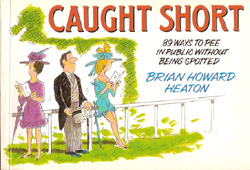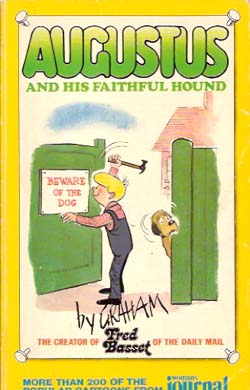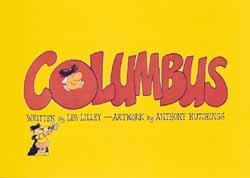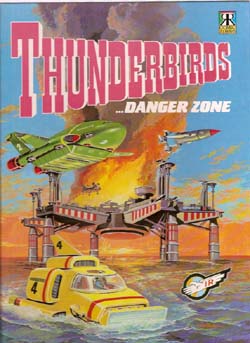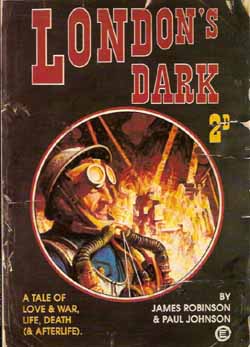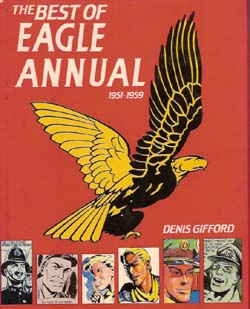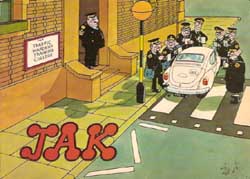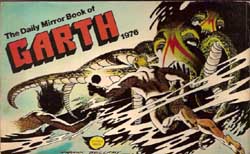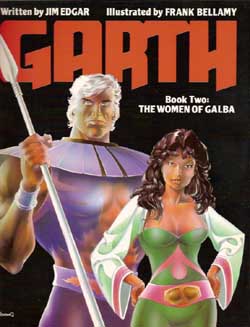
By Jim Edgar and Frank Bellamy (Titan Books)
ISBN: 0-907610-49-8
The second 1980s Titan Books collection of the Frank Bellamy Garth spans the period from 7th September 1972 to 25th October 1973 and shows the artist at the absolute peak of his powers. (These great old volumes are still available through some internet vendors such as Amazon.com – and I know because I just checked – but it never hurts to simply Google the title of a book if you’re interested in it)…
Garth was the British answer to America’s publishing phenomenon Superman and first appeared in the Daily Mirror on Saturday, July 24th 1943, the creation of Steve Dowling and BBC producer Gordon Boshell, joining the regular comic strip features, Buck Ryan, Belinda Blue Eyes, Just Jake and the irrepressible, morale-boosting glamour-puss Jane.
A blond giant and physical marvel, Garth washed up on an island shore and into the arms of a pretty girl, Gala, with no memory of who he was, just in time to save the entire populace from a tyrant. Boshell never actually wrote the series, so Dowling, who was also producing the successful family strip The Ruggles, scripted Garth until a writer could be found.
Don Freeman dumped the amnesia plot in ‘The Seven Ages of Garth’ (which ran from September 18th 1944 until January 20th 1946) by introducing the studious jack-of-all-science Professor Lumiere whose psychological experiments regressed the hero back through his past lives. In the next tale ‘The Saga of Garth’ (January 22nd 1946 – July 20th 1946) his origin was revealed. Found floating in a coracle off the Shetlands, baby Garth was adopted by a kindly old couple. Growing to vigorous manhood he returned to the seas as a Navy Captain until he was torpedoed off Tibet in 1943.
Freeman continued as writer until 1952 and was briefly replaced by script editor Hugh McClelland until Peter O’Donnell took over in 1953. He wrote 28 adventures but resigned in 1966 to devote more time to his own Modesty Blaise feature. His place was taken by Jim Edgar; who also wrote the western strips Matt Marriott, Wes Slade and Gun Law.
In 1968 Dowling retired and his assistant John Allard took over the drawing until a permanent artist could be found. Allard had completed ten tales when Frank Bellamy came on board with the 13th instalment of ‘Sundance’ (see Garth: The Cloud of Balthus ISBN: 0-90761-034-X). Allard remained as background artist/assistant until Bellamy took full control during ‘The Orb of Trimandias’.
Professor Lumiere had discovered something which gave this strip its distinctive appeal – even before the fantastic artwork of Bellamy elevated it to dizzying heights of graphic brilliance: Garth was blessed – or cursed – with an involuntary ability to travel through time and experience past and future lives. This concept gave the strip infinite potential for exotic storylines and fantastic exploits, pushing it beyond its humble origins as a Superman knock-off.
This volume begins with the eerie chiller ‘The People of the Abyss’ wherein Garth and sub-sea explorer Ed Neilson are captured by staggeringly beautiful – and naked! – women who drag their bathyscaphe to a city at the bottom of the Pacific where they are at war with horrendous aquatic monstrosities. But even that is merely the prelude to a tragic love affair with Cold War implications…
Next up is the eponymous space-opera romp ‘The Women of Galba’ wherein another alien tyrant learns to rue the day he abducted a giant Earthman to be a gladiator. Exotic locations, spectacular action and oodles of astonishingly beautiful females make this an unforgettable adventure.
“Ghost Town†is a western tale, and a very special one. When Garth, holidaying in Colorado, rides into ‘Gopherville’ an abandoned mining town, he is drawn back to a past life as Marshal Tom Barratt who lived, loved and died when the town was a hotspot of vice and money. When Bellamy died suddenly in 1976 this tale, long acknowledged as his favourite was rerun until Martin Asbury was ready to take over the strip.
The final adventure ‘The Mask of Atacama’ finds Garth and Professor Lumiere in Mexico City. In his sleep the hero is visited by the spirit of beautiful Princess Atacama who brings him through time to the Aztec City of Tenochtitlan where as the Sun God Axatl he hopes to save their civilisation from the marauding Conquistadores of Hernan Cortés, but neither he nor the Princess have reckoned on the jealousy of the Sun Priests and their High Priestess Tiahuaca…
Of especial interest in this volume are a draft synopsis and actual scripts for ‘The Women of Galba’, liberally illustrated, of course. There has never been a better adventure strip than Garth as drawn by Bellamy, combining action, glamour, mystery and the fantastic into a seamless blend of graphic wonderment. Of late, Titan Books has published a magical run of classic British strips and comics. I’m praying that Garth also is in their sights, and if he is it’s up to us to make sure that this time the books find a grateful, appreciative and huge audience…
© 1985 Mirror Group Newspapers/Syndication International. All Rights Reserved.
